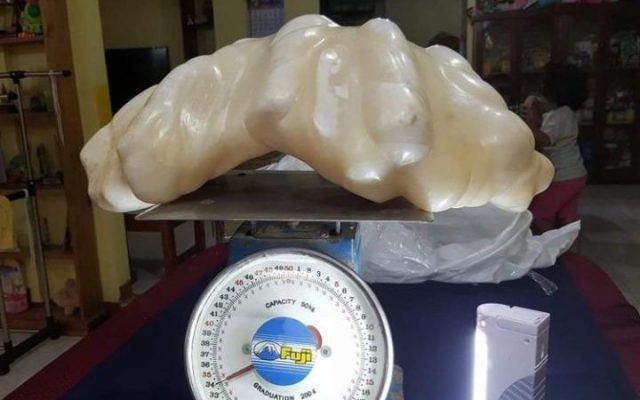A fisherman kept a world record pearl worth ‘millions’ under his bed for a decade
The next time you go fishing or diving – keep an eye out for massive pearls and you could be worth millions overnight.
A Filipino fisherman who kept the ‘mother of all pearls’ under his bed for ten years had no idea how valuable this pearl is. The enormous 77lbs (34kg) pearl, which is the biggest natural pearl ever found.

Aileen Cynthia Amurao who is a Tourism officer said: ‘The fisherman threw the anchor down and it got stuck on a rock during a storm.He noticed that it was lodged on a shell and swam down to pull up the anchor, and also brought the shell with him. This was a decade ago and he kept it at home.
‘He didn’t know how much it was worth and kept it tucked away at home as a simple good luck charm. We were amazed when he brought it to us. We now need help from gemologists to fully certify it. We’re waiting for authentication from Gemologist Institute and other international authorities.But we believe Puerto Princesca is likely earn another prestigious title and a record breaker for having the world’s biggest natural giant pearl from a giant clam”. A British newspaper is reporting that the giant pearl could be worth as much as $100 million.
The previous record holder was The Pearl of Lao Tzu used to be the largest known pearl. The pearl was found in the Palawan sea, which surrounds the island of Palawanin the Philippines, and was found by a Filipino diver. It is not considered a gemstone pearl, but is instead known as a “clam pearl” or “Tridacna pearl” from a giant clam. It measures 24 centimeters in diameter (9.45 inches) and weighs 14.1 lb (6.4 kgs).

The Pearl of Lao Tzu came from Brooke’s Point, Palawan in the Philippines. Wilburn Cobb, an American who brought the pearl from the Philippines in 1939 and owned it until his death in 1979, published an account of how he came to own it in Natural History magazine.
According to Cobb, he wanted to buy it from a Philippine tribal chief when he first heard of it in 1934, but the chief, a Muslim, did not want to sell because he considered the pearl sacred, in part because of its resemblance to the turbaned head of the Islamic prophet,Muhammad. However, Cobb relates, he saved the life of the chief’s son, who was stricken with malaria, in 1936 and was given the pearl as a token of gratitude. Because of its sacred associations, the pearl came to be known as the Pearl of Allah.
Much later, Cobb wrote a new account in the February 1969 Mensa Bulletin, this time promoting the pearl as an artifact of Chinese legend. He alleged he had been approached by a Chinese man named Li, who told him that the pearl had first been grown in a much smaller clam around a jade amulet inserted by a disciple of the legendary sage Laozimore than 2,500 years ago, and been transferred over the centuries to ever larger clams, growing to record size. Wars had supposedly been fought over the artifact, and it had been sent off to the Philippines as a protective measure, where it was lost in a storm.





